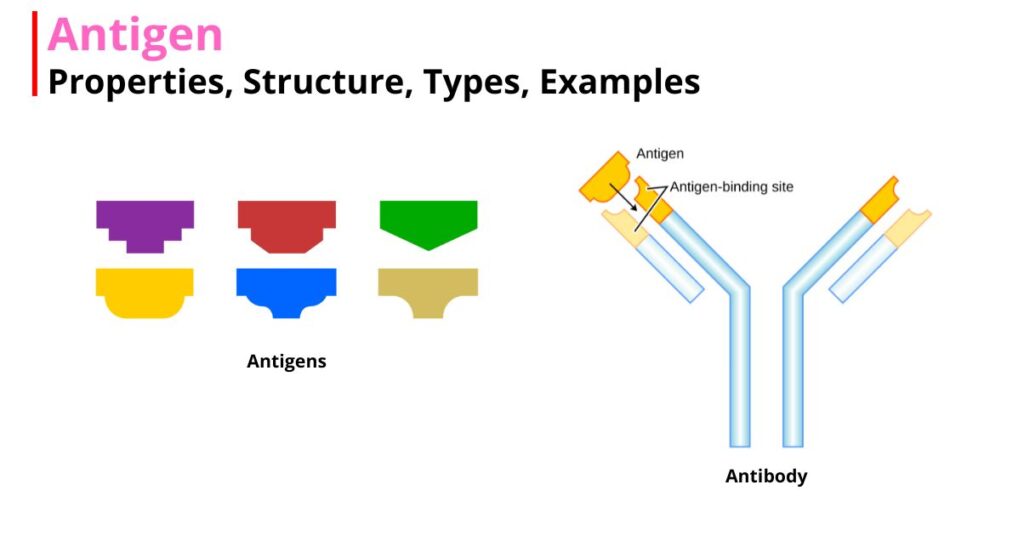Acquired immunity does not occur unless foreign microbes or toxins enter the body. Each microbe or toxin contains one or more specific chemical substances that play an important role in triggering acquired immunity. These substances are mainly proteins, peptides, polysaccharides, or lipoproteins. These molecules or substances are called antigens.
Antigens (Ag) are substances that are foreign to the body and trigger an immune response, producing antibodies against them.

General Properties of Antigens
Some important properties of antigens are as follows:
Chemical Nature
- Most antigens are proteins.
- Some are polysaccharides and lipoproteins in nature.
- Nucleic acids can also act as antigens if complexed with proteins and polysaccharides.
- Simple proteins (homopolymers) are usually less immunogenic.
Foreign Nature
- All antigens are foreign to the body.
- However, there are some proteins occurring within the host body that might also induce an immune response. These proteins are called autoantigens.
Molecular Size
- The molecular size of effective antigens generally greater than 10000 Da.
- The ideal antigen should have a molecular weight of approximately 100000 Da.
- Haptens are low molecular weight substances and are considered partial antigens.
Molecular Rigidity and Complexity
- Usually, rigid molecules are good antigens. They can increase the number of antibodies to certain structures.
- The structural complexity of an antigen is also plays a crucial role in its immunogenecity.
- A simple, repeating sequence of a single amino acid is less likely to trigger an immune response than a more complex sequence with multiple amino acid units.
Antigenic Determinants and Cross-reactivity
- Antigenic determinants are the specific regions of an antigen that interact with and bind to antibodies, triggering an immune response.
- Antigens usually need two or more antigenic determinants to induce antibody production. Thus, small antigens cannot induce antibodies, as they have only one antigenic determinant.
- Cros-reactivity of antigens, where antibodies induced by a different antigen can recognize and bind to another antigen.
Structure of Antigen
- The structure of antigens depends on their nature, size, and immunogenicity.
- They have a structural component known as an epitope or antigenic determinant where the antigen is involved in the reaction with antibodies.
- Most antigens consist of many epitopes.
- The region of antibodies that interacts with antigens is called a paratope or antigen binding site.
- The epitope and paratope fit together like a lock and key, showing how their specific shapes match perfectly, allowing them to bind precisely.
Types of Antigens
There are several types of antigens, classified based on different factors. The most common factor in antigen classification is their origin and immunogenic properties.
Types of antigen-based on their origin
On the basis of their origin, antigens are two types: exogenous antigens and endogenous antigens.
Exogenous Antigens
- Exogenous antigens are the antigens that originate from outside the body of the host.
- They are foreign to the host and can trigger an immune response.
- Exogenous antigens enter the body through the skin, respiratory, gastrointestinal or genitourinary tracts.
- These antigens can cause inflammation, allergic reactions or immune-mediated diseases.
- Examples: Allergens (peanut, pollen, dust mite), Disease-causing microbes (Influenza virus, Tuberculosis bacteria, HIV), and Vaccine antigens (HPV, Hepatitis B).
Endogenous Antigens
- Endogenous antigens are the antigens that produce within the body of the host during metabolism or as a result of intracellular bacterial or viral infection.
- These are usually the cells of the body, compounds, or antigenic products of metabolism.
- Examples: Forssman (found in the red blood cells in rats, cats, horses, etc.) and cardiolipin (found in the hearts of mammals).
- Endogenous antigens are many types, such as xenogenic antigen (derived from a different species), autologus antigen (originated from self-tissue or cells), and allogenic antigen (derived from genetically different individuals of the same species).
Types of antigens on the basis of immune response
On the basis of immune response, antigens can be categorized into two groups: complete antigens and incomplete antigens.
Complete Antigens or Immunogens
- Complete antigens, or immunogens, are antigens that can induce a full immune response, including both B-cell and T-cell activation.
- These antigens are able to generate immune response by themselves without any carrier particles.
- These are mostly proteinaceous in nature and have a high molecular weight (more than 10000 Da).
Incomplete Antigens or Haptens
- Incomplete antigens, also known as haptens, are molecules that cannot generate a full immune response by themselves.
- These are non protein substances that require a carrier protein (molecule) to induce immunity.
- These substances have a low molecular weight (less than 10000 Da).
